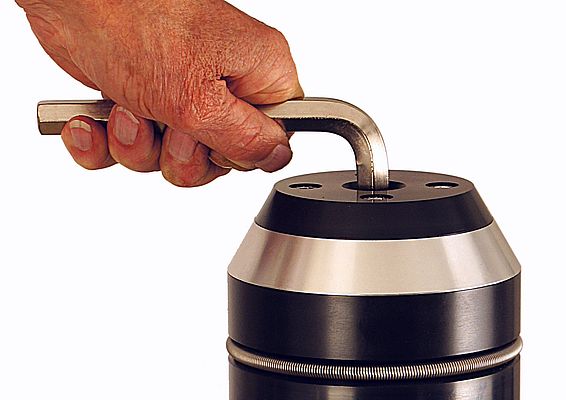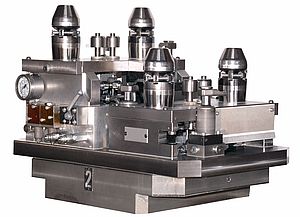Plant and production managers are paying particular attention to reducing inefficient auxiliary process times everywhere in production technology. In this process, attention is turned again and again to the optimisation of the clamping equipment used.
A renowned manufacturer of automotive devices, for example, was seeking a suitable clamping technique for the fully-automatic robotic welding of sheet-steel components which is both precise and efficient. The company chose WPR's dynamic multi-level internal clamp. It takes just a few seconds for the robot to join the two deep-drawn sheet-steel half shells in the spot-welding process.
A hollow body with a clad opening in its centre is formed in record time - the shape resembles a large donut. The passage has a diameter of +/- 85 mm and is formed by the fusion of the 12-mm edges of the two half shells. It is of primary interest from a manufacturing perspective.
This is because it enables the system builder - a manufacturer of production systems for the automotive industry - to use a clamping device for the robot-supported spot welding of half shells, which is considered the ideal solution for attaching workpieces with holes or openings: The dynamic multi-level internal clamp produced by WPR. This system referred to as the centring clamp in professional circles is manufactured in many versions, with WPR applying a few basic designs to produce nearly every multi-level internal clamp as a customised solution.
The height and diameter of the centring clamp and the position of its sling point are designed for the concrete application and the number of clamping levels and shape of the clamped element. Clamping in two stages WPR designed its centring clamp for the robotic spot welding of the device manufacturer as a manual clamping system with two levels.
The special feature here: This design clamps anti-cyclically! This means that the two sheet-steel half shells, which are aligned on top of each other as mirror images, are "capped" consecutively by the centring clamp in two independent stages in quick succession. The second clamping level fastens the upper shell only after the first clamping level has fastened the lower shell.
This occurs for reasons of precision and process reliability. Because the diameter of the passage in the centre of the opening of the two positioned half shells always varies slightly. Thanks to its two independently acting clamping levels and their floating clamping elements, however, the WPR internal clamp can easily compensate these tolerances.
It ensures in this way that the two half shells are always exactly aligned in the vertical axis when they are clamped - and thus creates the basic condition for the precision and repeat accuracy of the spot-welding robot travel along the outside edge of the half shells. Very precise and efficient with its anti-cyclical two-level internal clamp for the component manufacturer's robotic welding system, WPR has not only produced a highly accurate clamping device but has also developed an extremely efficient solution.
Because the user can implement two clamping actions with a single tool, i.e. in one process. This greatly reduces the auxiliary process times. Multi-part clamping systems, which would require prolonged setup times, can be completely eliminated. The only tool required by the user to operate the manual WPR centring clamp is a simple hexagon wrench.
The WPR multi-level internal clamp is virtually unbeatable when the workpieces to be clamped have a hole or opening of at least 12 mm. This is because the clamping device can be used not only for welding and assembly tasks but also in the broad field of mechanical processing. Its maximum clamping force is 10 kN and its repeat accuracy +/- 0.05 mm when the workpiece is changed. WPR designs its centring clamp for manual, pneumatic, or hydraulic operation, depending on the application and periphery.


















